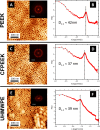Functionalizing Nonfunctional Surfaces: Creation of Metal Oxide Nanopatterns on High-Performance Polymers via Self-Assembly of PS- b-PEO
- PMID: 40202904
- PMCID: PMC12022950
- DOI: 10.1021/acsami.5c04225
Functionalizing Nonfunctional Surfaces: Creation of Metal Oxide Nanopatterns on High-Performance Polymers via Self-Assembly of PS- b-PEO
Abstract
High-performance polymers are pivotal for a wide range of applications due to their excellent mechanical, chemical, and thermal properties. This work introduces, for the first time, a block copolymer (BCP) self-assembly method to modify the surfaces of different high-performance polymers. Using highly ordered poly(styrene-b-ethylene oxide) (PS-b-PEO) thin films as templates, metallic oxide nanopillars (Al2O3, Ag2O, MgO, CaO, and TiO2) with a 20 nm average diameter were fabricated. These were created on high-performance polymer substrates, specifically, polyetheretherketone (PEEK), carbon fiber-reinforced polyetheretherketone (CFPEEK), and ultrahigh molecular weight polyethylene. This method addresses the low chemical activity of these polymeric substrates, offering a cost-effective, scalable solution to produce their surface functionalization. Characterization via atomic force microscopy, scanning electron microscopy, and X-ray photoelectron spectroscopy validate the structure and composition of the nanostructured surfaces. The significance of BCP self-assembly is emphasized as an effective and versatile approach for the nanoscale tailoring of surface properties in high-performance polymers. This process offers a straightforward method with low technological and energetic costs, paving the way for the extensive surface modification of large areas. The implications of this work extend to various sectors, including biomedical devices, sensors, and electronics, showcasing the broad applicability of this nanoscale tailoring technique.
Keywords: block copolymer self-assembly; high-performance polymers; metal oxide nanopatterns; nanopatterning methodologies; nanostructures; surface functionalization; surface modification techniques.
Conflict of interest statement
The authors declare no competing financial interest.
Figures








Similar articles
-
Negative-tone block copolymer lithography by in situ surface chemical modification.Small. 2014 Oct 29;10(20):4207-12. doi: 10.1002/smll.201400971. Epub 2014 Jun 10. Small. 2014. PMID: 24912807
-
Polystyrene-block-poly(ethylene oxide) Thin Films Fabricated from a Solvent Mixture for the Co-Assembly of Polymers and Proteins.ACS Omega. 2020 Oct 8;5(41):26365-26373. doi: 10.1021/acsomega.0c02392. eCollection 2020 Oct 20. ACS Omega. 2020. PMID: 33110964 Free PMC article.
-
Highly Ordered Porous Inorganic Structures via Block Copolymer Lithography: An Application of the Versatile and Selective Infiltration of the "Inverse" P2VP-b-PS System.ACS Appl Mater Interfaces. 2022 Aug 3;14(30):35265-35275. doi: 10.1021/acsami.2c10338. Epub 2022 Jul 25. ACS Appl Mater Interfaces. 2022. PMID: 35876355
-
Interfacially formed organized planar inorganic, polymeric and composite nanostructures.Adv Colloid Interface Sci. 2004 Nov 29;111(1-2):79-116. doi: 10.1016/j.cis.2004.07.005. Adv Colloid Interface Sci. 2004. PMID: 15571664 Review.
-
Electrochemical Manipulation of Aligned Block Copolymer Templates.Macromol Rapid Commun. 2020 Jan;41(1):e1900485. doi: 10.1002/marc.201900485. Epub 2019 Nov 27. Macromol Rapid Commun. 2020. PMID: 31774602 Review.
References
-
- McKeen L. W. In The Effect of Creep and Other Time Related Factors on Plastics and Elastomers (Second ed.), second ed. ed.; McKeen L. W., Ed.; Plastics Design Library; William Andrew Publishing: Boston, 2009; pp 337–372.
-
- Cassidy P. E.; Aminabhavi T. M.; Reddy V. S.. Kirk-Othmer Encyclopedia of Chemical Technology; John Wiley & Sons, Ltd, 2000; p 1.
-
- Kurdi A.; Chang L. Recent Advances in High Performance Polymers—Tribological Aspects. Lubricants 2019, 7, 2.10.3390/lubricants7010002. - DOI
-
- de Leon A. C.; Chen Q.; Palaganas N. B.; Palaganas J. O.; Manapat J.; Advincula R. C. High performance polymer nanocomposites for additive manufacturing applications. React. Funct. Polym. 2016, 103, 141–155. 10.1016/j.reactfunctpolym.2016.04.010. - DOI
-
- Fink J. K.High Performance Polymers, 2nd ed ed.; Elsevier, 2014; pp 1–420.
LinkOut - more resources
Full Text Sources

